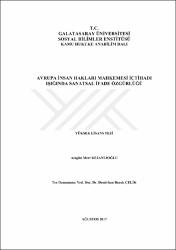Please use this identifier to cite or link to this item:
https://hdl.handle.net/20.500.11779/1083Full metadata record
| DC Field | Value | Language |
|---|---|---|
| dc.contributor.advisor | Çelik, Demirhan Burak | - |
| dc.contributor.author | Kejanlıoğlu, Atagün Mert | - |
| dc.date.accessioned | 2019-05-16T14:20:30Z | - |
| dc.date.available | 2019-05-16T14:20:30Z | - |
| dc.date.issued | 2017 | - |
| dc.identifier.citation | Kejanlıoğlu, A.M. (2017). Avrupa İnsan Hakları Mahkemesi içtihadı ışığında sanatsal ifade özgürlüğü, Galatasaray Üniversitesi, Sosyal Bilimler Enstitüsü, Kamu Hukuku Anabilim Dalı, İstanbul, Turkiye | en_US |
| dc.identifier.uri | https://hdl.handle.net/20.500.11779/1083 | - |
| dc.description.abstract | Sanatsal ifade özgürlüğü Avrupa İnsan Hakları Mahkemesi (AİHM) kararlarında ifade özgürlüğünü koruyan 10. madde kapsamında korunan bir özgürlüktür. Bu durum bu özgürlüğe özel olarak adanmış çalışmaların sayısını azaltmasına neden olmaktadır. Ayrıca özgürlüğün sınırlarını kesin olarak belirlemek zordur; çünkü sanatın tanımı üzerinde uzlaşma yoktur. Bu doğrultuda, Mahkemenin geliştirdiği korumanın sanat için yeterince koruyucu bir alan sağlayıp sağlamadığını göstermek için, sanatın ne olduğu ve nitelikleri tartışılacaktır. Bununla birlikte bu özgürlüğün kapsamı açıklanacak, bu kapsamın nasıl sınırlandığı ve AİHM'in yaklaşımının sanatın gereklerine uygun olup olmadığı ise AİHM içtihadındaki takdir marjı doktrini ışığında incelenecektir. | en_US |
| dc.description.abstract | Freedom of artistic expression is protected under Article 10 of European Convention on Human Rights according to the European Court of Human Rights' case law. This is one of the main reasons why there are very few studies on this issue. Besides, it is difficult to determine the contours of this freedom as there is no consensus on art's definition. In this vein, several definitions proposed to define what art is, and reasons for legally protecting art will be analyzed in order to establish whether the Court's approach is compatible with the qualities of art. Moreover, scope of this right, restrictions imposed to this freedom and the compatibility of the Court's approach with modus operandi of art will be studied with reference to the Court's margin of appreciation doctrine. | en_US |
| dc.language.iso | tr | en_US |
| dc.publisher | Galatasaray Üniversitesi, Sosyal Bilimler Enstitüsü, Kamu Hukuku Anabilim Dalı | en_US |
| dc.rights | info:eu-repo/semantics/openAccess | en_US |
| dc.subject | Research Subject Categories::LAW/JURISPRUDENCE::Public law | en_US |
| dc.subject | İfade özgürlüğü | en_US |
| dc.subject | Avrupa İnsan Hakları Hukuku | en_US |
| dc.subject | Sanat | en_US |
| dc.subject | Sanatsal ifade | en_US |
| dc.subject | Temel haklar | en_US |
| dc.subject | AİHM | en_US |
| dc.title | Avrupa İnsan Hakları Mahkemesi içtihadı ışığında sanatsal ifade özgürlüğü | en_US |
| dc.title.alternative | Freedom of artistic expression from the perspective of European Court of Human Rights' case law | en_US |
| dc.type | Master Thesis | en_US |
| dc.description.PublishedMonth | Ağustos | en_US |
| dc.relation.publicationcategory | Tez-Diğer | en_US |
| dc.identifier.endpage | 182 | en_US |
| dc.identifier.startpage | 1 | en_US |
| dc.department | Hukuk Fakültesi, Anayasa Hukuku Anabilim Dalı | en_US |
| dc.institutionauthor | Kejanlıoğlu, Atagün Mert | - |
| item.grantfulltext | open | - |
| item.fulltext | With Fulltext | - |
| item.languageiso639-1 | tr | - |
| item.openairetype | Master Thesis | - |
| item.openairecristype | http://purl.org/coar/resource_type/c_18cf | - |
| item.cerifentitytype | Publications | - |
| crisitem.author.dept | 05. Faculty of Law | - |
| Appears in Collections: | Hukuk Fakültesi Koleksiyonu | |
Files in This Item:
| File | Description | Size | Format | |
|---|---|---|---|---|
| 4755122222.pdf | Tez Dosyası | 2.39 MB | Adobe PDF |  View/Open |
CORE Recommender
Page view(s)
50
checked on Nov 18, 2024
Download(s)
8
checked on Nov 18, 2024
Google ScholarTM
Check
Items in GCRIS Repository are protected by copyright, with all rights reserved, unless otherwise indicated.